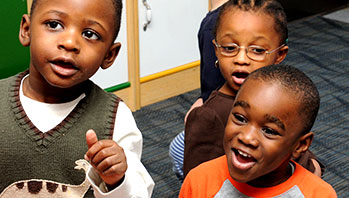- variety of tubes, including cardboard tubes from toilet paper, paper towels, and wrapping paper
- higher
- louder
- lower
- pitch
- softer
- voice
- volume
MA Standards:
Speaking and Listening: SL.PK.MA.1a Observe and use appropriate ways of interacting in a group (e.g., taking turns in talking, listening to peers, waiting to speak until another person is finished talking, asking questions and waiting for an answer, gaining the floor in appropriate ways).
Foundational Skills: RF.PK.MA.2 With guidance and support, demonstrate understanding of spoken words, syllables, and sounds (phonemes).
MA Draft STE Standards:
Physical Sciences/Matter and Its Interactions/PS4.B Apply their understanding in their play of how to change volume and pitch of some sounds.
Head Start Outcomes:
Social Emotional Development/Self-Regulation Follows simple rules, routines, and directions.
Language Development/Receptive Language Attends to language during conversations, songs, stories, or other learning experiences.
PreK Learning Guidelines:
English Language Arts/Language 1 Observe and use appropriate ways of interacting in a group (taking turns in talking; listening to peers; waiting until someone is finished; asking questions and waiting for an answer; gaining the floor in appropriate ways).
English Language Arts/Reading and Literature 12 Listen to, recite, sing, and dramatize a variety of age-appropriate literature.
Recite Together: “Jazz Baby, Jazz Baby” #2

© Commonwealth of Massachusetts, Department of Early Education and Care (Jennifer Waddell photographer). All rights reserved.
STEM Key Concepts: Sounds vary in three ways: volume (loud or soft), pitch (high or low), and timbre (quality); Sounds sound different when they travel through a hollow object
ELA Focus Skills: Phonological Awareness (Rhythm), Fine Motor Skills
Reread the poem “Jazz Baby, Jazz Baby.” Divide children into two groups; have one group recite the poem through tubes and have the other group act out the action words.
Tell children you want them to recite the poem a few more times. Alert them that each time they recite, you want them to change the volume and pitch of their voice as they say and act out the action words; for example, say, This time, make your voice higher (lower/louder/softer)!
Jazz Baby
Jazz Baby, Jazz Baby
Clap! Clap! Clap! (children say words and clap along)
Jazz Baby, Jazz Baby
Tap! Tap! Tap! (children say words and tap along)
Jazz Baby, Jazz Baby
Snap! Snap! Snap! (children say words and snap along)
Jazz Baby, Jazz Baby
Go to sleep!
Z-z-z-z-z-z-z-z-z. (children place hands together on side of face and make a /z/ sound, going from loud to soft)
Educator Tip: If children are having difficulty reciting and doing the hand motions together, have them do the motions as you recite the poem a few times first.
